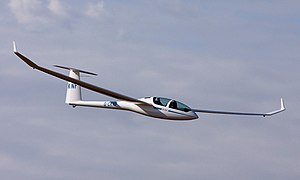

| DG-1000 | |
|---|---|

| |
| DG-1000 with 20 metre wingspan. | |
| Role | Two-Seater Class sailplane
Type of aircraft
|
| National origin | Germany |
| Manufacturer | DG Flugzeugbau |
| First flight | July 2000 |
The DG Flugzeugbau DG-1000 is a two-seater class glider built by DG Flugzeugbau. It first flew in July 2000 at Speyer in Germany.[1] There are four models, with 18- and 20-metre wings[1] of HQK-51 profile. The latest DG-1001 variant replaced the DG-505 in production.[2]
With 18 m (59 ft) span wings it is fully certified for aerobatics (+7-5 g); with a 20 m (66 ft) span wings it is certified for limited aerobatics (+5-2.65 g).
The engine (DG1000T) is mounted on a pylon aft of the double cockpit. There is a reduction gear (2.3:1.0) between the engine and the two-blade carbon-fibre composite propeller. The propeller was designed by and made in the DG factory.
In 2011, the DG-1000 was selected by the USAF as a replacement for the Blanik TG-10. It will serve as a basic soaring trainer for cadets at the United States Air Force Academy. It also serves as the primary competition platform for the USAF Academy Aerobatic Demonstration Team. Its USAF designation is TG-16A.[3][4]

General characteristics
Performance
![]() Media related to Glaser-Dirks DG-1000 at Wikimedia Commons
Media related to Glaser-Dirks DG-1000 at Wikimedia Commons
|
Glaser-Dirks and DG Flugzeugbau aircraft
| |
|---|---|
|
|
| |||||||||||||
|---|---|---|---|---|---|---|---|---|---|---|---|---|---|
| USAAC/USAAF sequences (1924-1947) |
| ||||||||||||
| 1948 USAF redesignations |
| ||||||||||||
| Tri-service sequence (1962-present) |
| ||||||||||||
1 Not assigned | |||||||||||||